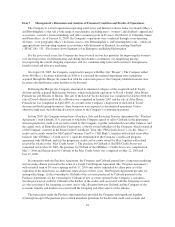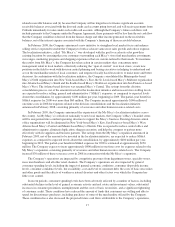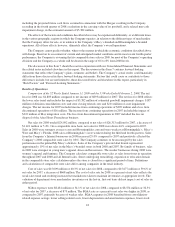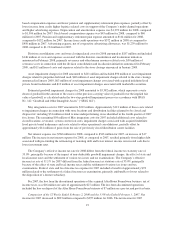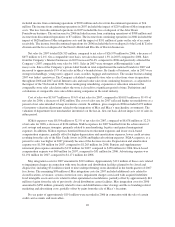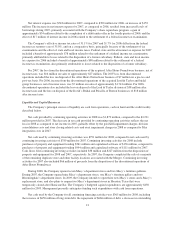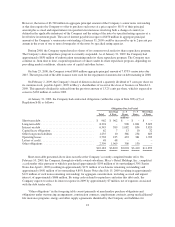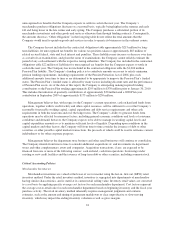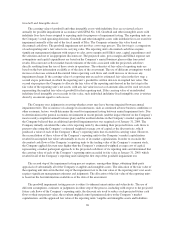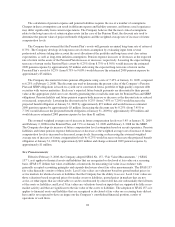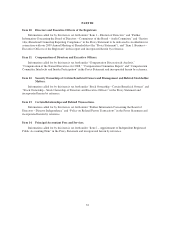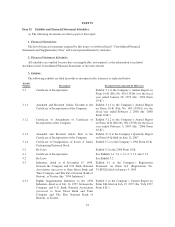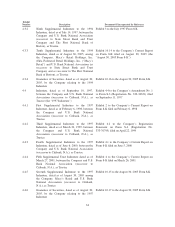Macy's 2008 Annual Report Download - page 30
Download and view the complete annual report
Please find page 30 of the 2008 Macy's annual report below. You can navigate through the pages in the report by either clicking on the pages listed below, or by using the keyword search tool below to find specific information within the annual report.unrecognized tax benefits that the Company expects to settle in cash in the next year. The Company’s
merchandise purchase obligations fluctuate on a seasonal basis, typically being higher in the summer and early
fall and being lower in the late winter and early spring. The Company purchases a substantial portion of its
merchandise inventories and other goods and services otherwise than through binding contracts. Consequently,
the amounts shown as “Other obligations” in the foregoing table do not reflect the total amounts that the
Company would need to spend on goods and services in order to operate its businesses in the ordinary course.
The Company has not included in the contractual obligations table approximately $215 million for long-
term liabilities for unrecognized tax benefits for various tax positions taken or approximately $65 million of
related accrued federal, state and local interest and penalties. These liabilities may increase or decrease over time
as a result of tax examinations, and given the status of examinations, the Company cannot reliably estimate the
period of any cash settlement with the respective taxing authorities. The Company has included in the contractual
obligations table $22 million of liabilities for unrecognized tax benefits that the Company expects to settle in
cash in the next year. The Company has not included in the contractual obligation table the $1,006 million
Pension Plan liability. The Company’s funding policy is to contribute amounts necessary to satisfy minimum
pension funding requirements, including requirements of the Pension Protection Act of 2006, plus such
additional amounts from time to time as are determined to be appropriate to improve the Pension Plan’s funded
status. The Pension Plan’s funded status is affected by many factors including discount rates and the performance
of Pension Plan assets. As of the date of this report, the Company is anticipating making required funding
contributions to the Pension Plan totaling approximately $295 million to $370 million prior to January 30, 2010.
This includes the initiation of quarterly contributions of approximately $30 million and a 2008 Plan year
contribution in September 2009 of approximately $175 million to $250 million.
Management believes that, with respect to the Company’s current operations, cash on hand and funds from
operations, together with its credit facility and other capital resources, will be sufficient to cover the Company’s
reasonably foreseeable working capital, capital expenditure and debt service requirements and other cash
requirements in both the near term and over the longer term. The Company’s ability to generate funds from
operations may be affected by numerous factors, including general economic conditions and levels of consumer
confidence and demand; however, the Company expects to be able to manage its working capital levels and
capital expenditure amounts so as to maintain sufficient levels of liquidity. Depending upon conditions in the
capital markets and other factors, the Company will from time to time consider the issuance of debt or other
securities, or other possible capital markets transactions, the proceeds of which could be used to refinance current
indebtedness or for other corporate purposes.
Management believes the department store business and other retail businesses will continue to consolidate.
The Company intends from time to time to consider additional acquisitions of, and investments in, department
stores and other complementary assets and companies. Acquisition transactions, if any, are expected to be
financed from one or more of the following sources: cash on hand, cash from operations, borrowings under
existing or new credit facilities and the issuance of long-term debt or other securities, including common stock.
Critical Accounting Policies
Merchandise Inventories
Merchandise inventories are valued at the lower of cost or market using the last-in, first-out (LIFO) retail
inventory method. Under the retail inventory method, inventory is segregated into departments of merchandise
having similar characteristics, and is stated at its current retail selling value. Inventory retail values are converted
to a cost basis by applying specific average cost factors for each merchandise department. Cost factors represent
the average cost-to-retail ratio for each merchandise department based on beginning inventory and the fiscal year
purchase activity. The retail inventory method inherently requires management judgments and contains
estimates, such as the amount and timing of permanent markdowns to clear unproductive or slow-moving
inventory, which may impact the ending inventory valuation as well as gross margins.
24




